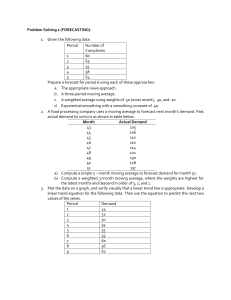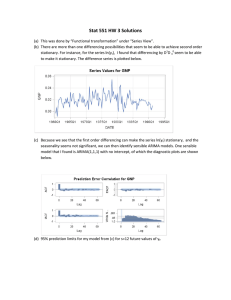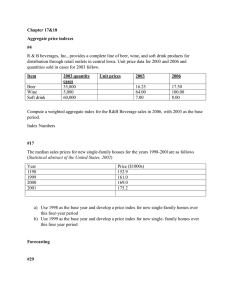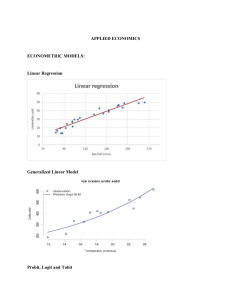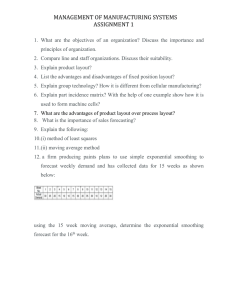R-package for Time Series Forecasting: ARIMA Models
advertisement
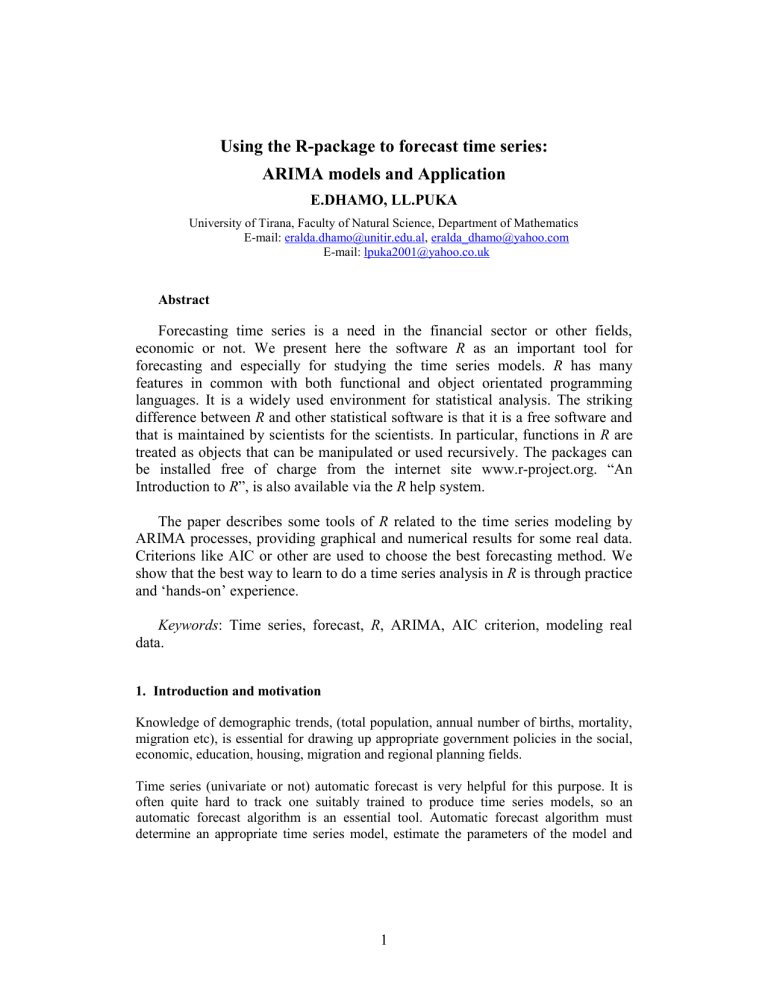
Using the R-package to forecast time series: ARIMA models and Application E.DHAMO, LL.PUKA University of Tirana, Faculty of Natural Science, Department of Mathematics E-mail: eralda.dhamo@unitir.edu.al, eralda_dhamo@yahoo.com E-mail: lpuka2001@yahoo.co.uk Abstract Forecasting time series is a need in the financial sector or other fields, economic or not. We present here the software R as an important tool for forecasting and especially for studying the time series models. R has many features in common with both functional and object orientated programming languages. It is a widely used environment for statistical analysis. The striking difference between R and other statistical software is that it is a free software and that is maintained by scientists for the scientists. In particular, functions in R are treated as objects that can be manipulated or used recursively. The packages can be installed free of charge from the internet site www.r-project.org. “An Introduction to R”, is also available via the R help system. The paper describes some tools of R related to the time series modeling by ARIMA processes, providing graphical and numerical results for some real data. Criterions like AIC or other are used to choose the best forecasting method. We show that the best way to learn to do a time series analysis in R is through practice and „hands-on‟ experience. Keywords: Time series, forecast, R, ARIMA, AIC criterion, modeling real data. 1. Introduction and motivation Knowledge of demographic trends, (total population, annual number of births, mortality, migration etc), is essential for drawing up appropriate government policies in the social, economic, education, housing, migration and regional planning fields. Time series (univariate or not) automatic forecast is very helpful for this purpose. It is often quite hard to track one suitably trained to produce time series models, so an automatic forecast algorithm is an essential tool. Automatic forecast algorithm must determine an appropriate time series model, estimate the parameters of the model and 1 compute the forecast. The most used automatic forecast algorithms, are based on exponential smoothing or ARIMA models. R is a software and programming language that enables one to study time series effectively. This paper is organized as follows: Section 2 gives details of the data used and introduces the methods of exponential smoothing, ETS and ARIMA. Section 3 introduces the forecast package in R language and fits the time series (the number of births in Albania from 1990 to 2008). We compare the performance of the already aforementioned models in Section 2. These models may be used then for life tables, mortality tables etc. In Section 4 we present some comments and findings. 2. The data, Exponential smoothing, ETS and ARIMA models The data used to demonstrate the forecast package in R, is taken from the Albanian Institute of Statistics (INSTAT) (www.instat.gov.al). The data consist of the number of births per month from 1990 to 2008. The entire dataset contains 228 observations. Rather than using the entire dataset, we first consider only the observation from January 1990 to December 2005, leaving aside the three years (from 2006 to 2008). Trying to build an appropriate model for the data, we compare three models for this subset of observations. The assessment of the best model is made through the predictive ability of each model. The three models we consider, are: exponential smoothing, ETS and ARIMA. Exponential smoothing methods have been around since the 1950s and were originally classified by Pegel‟s taxonomy (1969), extended later by other researchers, giving a total of fifteen methods. The table below shows the fifteen combinations. Table 1. The fifteen exponential smoothing methods Seasonal Component Trend Component N A M (No seasonality) (Additive) (Multiplicative) N (No trend) N, N N, A N, M A (Additive) A, N A, A A, M Ad (Additive damped) Ad, N Ad, A Ad, M M (Multiplicative) M, N M, A M, M Md (Multiplicative damped) Md, N Md, A Md, M 2 Forecast methods are numerous and they improve continuously. Some of them are: moving average, exponential smoothing, ARIMA, GARCH, Croston, Theta, cubic spline, Random Walk etc. The forecast methods are classified in three main groups: Univariate - used of past models ex: moving average, trend. Multivariate - used of past relation between multivariate variables ex: regression analysis. Qualitative - used of subjective judgement and other information. In Table 1, the commonly used methods are: cell (N,N) which describes the simple exponential smoothing method (or SES), cell (A,N) describes Holt‟s linear method, cell (A,A) describes the additive Holt-Winter‟s method and cell (A,M) gives the multiplicative Holt-Winter‟s method. The first model, an exponential smoothing model, is an algorithm producing point forecast only. The second model we consider, is proposed by Hyndman (2008) and it is noted (E,T,S). The triplet (E,T,S) refers to the three components: error, trend and seasonality. The notation helps in remembering the order in which the components are specified. The third model we consider in this paper, is the ARIMA model. Many people working with forecast, have difficulty using Autoregresive Integrated Moving Average (ARIMA) because of the order selection process. Actually many researchers have proposed methods to identify the order of an ARIMA model (Makridakis and Hibbon (2000); Liu (1989); Goodrich (2000); Reilly (2000)). For non-seasonal data we can consider ARIMA (p, d, q) models and for seasonal data we can consider ARIMA (p, d, q) (P, D, Q)m where m is the seasonal frequency. Based on the model of Box and Jenkins (1970) the seasonal autoregressive integrated moving average model is given by: p ( B s ) ( B)sDd X t Q ( B s ) ( B) wt Where, s = seasonal lag, coefficient for AR process, = coefficient for seasonal AR process, = coefficient for MA process, = coefficient for seasonal MA process. B is the backward shift operator,sD= (1 – Bs)D and d = (1- B)d, wt is an uncorrelated random variable with mean zero and constant variance. 3 3. Forecast package in R All methods are acceptable in certain circumtances, but the quality of forecast is related with the selection of the model. The calculations need time and often are doubvious for the fitness of the model. Generally, there is not one method that performs better in all time series. For time series with different specification, there are different methods that perform in a more efficient way. Use of forecasting techniques in R language, needs installation of some statistics package. Some of the main support package for forecast in R are: expsmooth, Mcomp, fma, pastec, psych, Hmisc, nls2, nlme, dynlm, dynamicGraph, lmtest, psplin; see for details in http://CRAN.R-project.org/package=forecasting . 3.1 Reading and organisation of data in R In most cases in our practice, the data is saved in an Excel format. The data from INSTAT-Albania is saved in Excel 2007 format. Working with this data in R enviroment, means that they must be saved in csv format (comma separated delimited). The comand read.csv (file.choose()) is one of the reading commands to transfer an Excel sheet in R. When working with time series in R, first, the data must be converted in a time series format so that R may recognise. So, we convert in a time series the number of births per month from January 1990 to December 2005 using the ts() command. > T=read.csv(file.choose())#chooses the excel file where are the data. T is the vector of values from January 1990 to December 2005. > SS=ts(T) #converts the data in a time series format > SS Time Series: Start = 1 End = 192 Frequency = 1 X0 [1,] 6077 [2,] 6488 ... > plot(SS, main="Number of Births form 1990 to 2005",ylab="Number of births",col="blue") 4 6000 5000 3000 4000 Number of births 7000 8000 Number of Births form 1990 to 2005 0 50 100 150 Time Figure 1. The number of births per month form January 1990 to December 2005 To build the model we need to arrange the data with frequency m=12. Data as follows: > SS5=ts(SS,start=1990,frequency=12) > SS5 1990 Jan Feb Mar Apr May 6077 6488 7720 7555 8130 ... ... ... ... 2887 2957 2991 3419 ... 2005 3092 Jun Jul 7555 7473 ... ... 3245 3307 Aug Sep Oct Nov 7145 6981 6324 5257 ... ... ... 3586 4177 3795 3034 Dec 3.2 1990 3122 ... ... 2005 5420 Exponential smoothing, Holt Winter’s method Using the HoltWinters(), we smooth the time series and find the smoothing parametres. > HW=HoltWinters(SS5) In our data the model is: Holt-Winter‟s exponential smoothing with trend and additive seasonal component and the smoothing parameters are: alpha: 0.7294214 ; beta : 0; gamma: 1 (see the smoothing in Figure 2). 5 > plot(HW,col="blue") 6000 5000 3000 4000 Observed / Fitted 7000 8000 Holt-Winters filtering 1995 2000 2005 Time Figure 2. The Holt-Winter‟s smoothing (blu line= the original data, red line= the smoothed data) In order to judge the accuracy of the model, we consider the data from January 1990 to December 2008. The accuracy of the forecast is evaluated by one of the following criteria according to circumstance: ME, RMSE, MAE, MPE, MAPE, MASE, AIC, AICC, BIC. >HoltWintersForecast<-predict(HW,36,prediction.interval= TRUE) # the smoothing time series and the forecast with the prediction interval > HoltWintersForecast Fit upr lwr Jan 2006 2707.779 3899.939 1515.61869 Feb 2006 2430.338 3905.949 954.72754 ... ... ... A plot of the real data, forecasted values and intervals is shown in the following: 6 Figure 3. The Holt-Winter‟s smoothing (blu line= the original data and the upper and lower border of the forecast interval, red line= the smoothed data ) A detailed graph of the observed data from January 1990 to December 2008, the smoothed values using the time series with observations 1990-2005 and the smoothed values using the time series with observation 1990 – 2008 is shown below. 4000 2000 Observed / Fitted 6000 8000 Holt-Winters filtering 1995 2000 2005 2010 Time Figure 4. Holt-Winter‟s forecast (blue line=the original data ’90-‘05, red line= smoothed data based on original data ’90-’05, purple line= original data ’06-’08, green line= smoothed data based on the original data ’90-‘08) 7 3.3 Second model : ETS model ets() function gives only the model for the observed values and the smoothing parameters. The summary () command gives a summary of the model, the smoothing parameters and the forecasted values. So, the model for our data is: ETS(A,N,A) which has additive errors, no trend and additive seasonality. > summary(forecast(SS)) Forecast method: ETS(A,N,A) Model Information: ETS(A,N,A) Call: ets(y = object) Smoothing parameters: alpha = 0.9999 gamma = 1e-04 Initial states: l = 7499.4998 s = -560.9959 -627.2871 -90.4 205.6223 397.7078 696.0149 416.9466 299.9661 39.389 43.8771 -435.9757 -384.8651 sigma: 480.7723 AIC AICc BIC 3408.790 3411.163 3454.395 In-sample error measures: ME RMSE MAE MPE MAPE -19.8798397 480.7723060 329.4195487 -0.9382922 6.7947608 MASE 0.7959913 Forecasts: Point Forecast Lo 80 Hi 80 Lo 95 Hi 95 Jan 2006 3298.174 2682.0391 3914.308 2355.87724 4240.470 … …. …. …. … Dec 2007 3122.000 103.8945 6140.105 -1493.79378 7737.793 We compare the values fitted from the ETS model (for the first 192 observations of the time series) and the whole time series (228 observations) in the graph derived by the commands: >par(mfrow=c(2,1)) >plot(forecast(SS),xlab="Time",ylab="Number of births") >lines(SS8,type="l",ylim=R,col="black") >plot(forecast(SS8),xlab="Time",ylab="Number of births") 8 0 6000 Number of births Forecasts from ETS(A,N,A) 1990 1995 2000 2005 Forecasts from ETS(M,N,M) 2000 Number of births Time 1990 1995 2000 2005 2010 Time Figure 5. The first graph shows the forecasted value and intervals of confidence from ETS(A,N A) model of number of births (black line= original data ’90-’08, blue line=forecast from ETS model, orange zone=interval of confidence 80%, yellow zone=interval of confidence 95%).The second graph shows the time series (1990-2008) the forecasted values and intervals of confidence from the ETS(M,N,M) model. As seen from Figure 5 the models are different. First model is ETS(A,N,A) and then when we add the data from January 2006 to December 2008 the model becomes an ETS(M,N,M). Figure 6 shows the time series with all the observation value from January 1990 to December 2008. > plot(SS8,main="Number of Births form 1990 to 2008",ylab="Number of births",col="blue")# SS8 is the time series with 228 values (1990 to 2008) 2000 3000 4000 5000 6000 7000 8000 Number of births Number of Births form 1990 to 2008 0 50 100 150 200 Time Figure 6. Original data taken from INSTAT Albania of number of births per month form 1990 to 2008 9 3.4 Third model: ARIMA model To fit the data by ARIMA model we use the command: > auto.arima(SS5) # SS5 time series data from 1990-2005 Series: SS5 ARIMA(1,1,1)(1,0,1)[12] Call: auto.arima(x = SS5) Coefficients: ar1 ma1 sar1 sma1 0.7004 -0.9657 0.9307 -0.7090 s.e. 0.0582 0.0155 0.0425 0.0871 sigma^2 estimated as 218215: log likelihood = -1448.58 AIC = 2907.16 AICc = 2907.48 BIC = 2923.42 > auto.arima(SS8) # SS8 time series data from 1990-2008 Series: SS8 ARIMA(1,1,1)(1,0,1)[12] Call: auto.arima(x = SS8) Coefficients: ar1 ma1 sar1 sma1 0.7075 -0.9674 0.9428 -0.7175 s.e. 0.0528 0.0142 0.0323 0.0722 sigma^2 estimated as 188954: log likelihood = -1705.24 AIC = 3420.48 AICc = 3420.76 BIC = 3437.61 > forecast(auto.arima(SS8)) Point Forecast Lo 80 Jan 2009 2932.194 2375.117 … … … … Dec 2010 2447.406 1497.329 Hi 80 3489.270 … … 3397.482 Lo 95 2080.2184 … … 994.3883 Hi 95 3784.169 3900.423 The model given by the command auto.arima() is a SARIMA (Seasonal Autoregressive Integrated Moving Average) model and is denoted as an ARIMA(p,d,q)(P,D,Q)[m] where m is the seasonal component. So the process is: ARIMA(1,1,1)(1,0,1)[12] ( for the data from 1990 to 2005 ) s = 12, =0.7004, = 0.9307, = -0.9657, = -0.7090 And, ARIMA(1,1,1)(1,0,1)[12] ( for the data from 1990 to 2008 ) 10 s = 12, =0.7075, = 0.9428, = -0.9674, = -0.7175 Graphical views of the models are shown below: > par(mfrow=c(2,1)) > plot(forecast(auto.arima(SS5)),xlab="Time",ylab="Number of births")#SS5 time series from ‘90-‘05 > lines(SS8,type="l",ylim=R,col="black")#SS8 time series from ’90-‘08 > plot(forecast(auto.arima(SS8)),xlab="Time",ylab="Number of births") 6000 2000 Number of births Forecasts from ARIMA(1,1,1)(1,0,1)[12] 1990 1995 2000 2005 Time 6000 2000 Number of births Forecasts from ARIMA(1,1,1)(1,0,1)[12] 1990 1995 2000 2005 2010 Time Figure 7. The first graph in Figure 7 shows the forecasted data and the confidence intervals from ARIMA(1,1,1)(1,0,1)[12] (1990 to 2005) model (black line= original data ’90-’08, blue line = forecast, orange zone=interval of confidence 80%, yellow zone=interval of confidence 95%). The second graph shows the time series (1990-2008) and the forecast of ARIMA(1,1,1)(1,0,1)[12] model for the period January 2009 to December 2010. As seen from the above, the model does not alter when we add the three years that we had previously excluded (2006, 2007 and 2008) but the coefficients does. Table 2 and Table 3 show some of the results and criteria used for the evaluation of the models. 11 Table 2. The Exponential smoothing and the ETS models results Coefficients alpha beta gamma a b s1 s2 s3 s4 s5 s6 s7 s8 s9 s10 s11 s12 ME RMSE MAE MPE MAPE MASE AIC AICC BIC Exp.Smoothing ’90-‘05 0.7294214 0 1 3693.27807 -40.81367 -944.68574 -1181.31251 -770.64387 -433.74647 403.08912 793.09847 1194.72672 1270.97556 1400.52101 648.44785 -330.24878 -571.27807 Exp.Smoothing ’90-‘08 0.6811137 0 1 2826.18221 -40.81367 -156.94856 -815.97413 -757.11361 -715.89701 -53.79534 145.47920 716.06274 778.20432 1409.93459 1065.26665 353.50813 179.81779 ETS (A,N,A) 0.9999 ETS (M,N,M) 0.7654 1 e-04 1 e-04 -560.9959 -627.2871 -90.4 205.6223 397.7078 696.0149 416.9466 299.9661 39.389 43.8771 -435.9757 -384.8651 -19.8798397 480.7723060 329.4195487 -0.9382922 6.7947608 0.7959913 3408.790 3411.163 3454.395 0.8879 0.8668 0.9898 1.0572 1.063 1.1367 1.0807 1.0722 1.0012 0.99 0.8972 0.9573 -24.5326955 465.4780546 323.1767185 -1.0516275 6.9702644 0.8231815 4036.809 4038.781 4084.820 Table 3. The SARIMA models Model ARIMA(1,1,1)(1,0,1)[12] 1990-2005 s.e ARIMA(1,1,1)(1,0,1)[12] 1990-2008 s.e ar1 ma1 sar1 sma1 AIC AICC BIC 0.7004 -0.9657 0.9307 -0.7090 2907.16 2907.48 2923.42 0.0582 0.0155 0.0425 0.0871 0.7075 -0.9674 0.9428 -0.7175 3420.48 3420.76 3437.61 0.0528 0.0142 0.0323 0.0722 12 4. Results and comments We used the forecast package of R language to show how to work on time series, when the main aim is forecast. The forecast package in R language works as an automatic forecast algorithm which can determine an appropriate time series model, estimate the parameters of the model and compute the forecast. R achieves the evaluation and forecast in a few seconds on modern computers. As R is created and maintained by scientist for the scientist, it is a language which can help not only in the applied field but in the research field as well. We want to emphasize that, finding the model with the lowest error criterion used, does not imply that it is the best model. The best way of choosing the appropriate model between those offered by the forecast package in R is to know how to manage your data and understand them. References Hyndman, R. J., Koehler, A. B., Snyder, R. D. & Grose, S. (2002): A state space framework for automatic forecasting using exponential smoothing methods, International Journal of Forecasting 18, 439–454. Hyndman R.J. ,King M.L., Pitrun I., Billah B. (2005): Local linear forecast using cubic smoothing splines. Australian & New Zealand Journal of Statistics, Volume 47, Issue 1 87-99 Hyndman R. J., Athanasopoulos G., Song H., Wu D.C., (2008): The tourism forecasting Competition Hyndman R.J., Khandakar Y. (2008): Automatic Time Series Forecasting: The forecast Package for R, Monash University, Journal of Statistical Software, Volume 27, Issue 3. (http://www.jstatsoft.org) Hydman R.J., Kostenko A.V. (2007): Minimum sample size requirements for seasonal forecasting models Pegels, C. C. (1969) Exponential smoothing: some new variations, Management Science, 12, 311–315. http://cran.r-project.org/web/views/TimeSeries.html, http://CRAN.R-project.org/package=forecasting. http://www.stat.pitt.edu/stoffer/tsa2/Examples.html 13 Some useful commands in forecast package ( R) abline( ) acf( ) arima( ) arima.sim( ) c( ) diff( ) filter( ) hist( ) HoltWinters( ) length( ) lines( ) lm( ) log( ) lsfit( ) mean( ) pacf( ) plot( ) predict( ) read.csv( ) rep( ) sd( ) seq( ) shapiro.test( ) stl( ) summary( ) ts( ) tsdiag( ) qqnorm( ) par() lag.plot() auto.arima() kpss.test() pp.test() adf.test() Graph command Autocorrelation function Fit an ARIMA model to the data Simulate an ARIMA model Command for a vector Vector of difference Filter a time series Histogram Holt Winter‟s procedure Length of a vector Graph command Linear model Logarithm of values Least square estimation Arithmetic mean Partial autocorrelation function. Graph command Prediction Import data in csv format Vectorial command Standard deviation Vectorial command Shapiro–Wilk test Seasonal decomposition of time series Summary function Converts the data to a time series Diagnostic of time series QQ plot Activate a new window Lag- plot Fit an ARIMA model to the data Kwiatkowski, Phillips, Schmidt and Shin (1992) test Phillips-Perron Unit Root Tests ADF test 14

